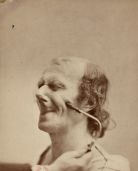Anatomical preparation and portraits
Guillaume-Benjamin Duchenne (de Boulogne), 1862
The Mechanism of Human Physiognomy, or the Electro-Physiological Analysis of the Expression of Passions pub'd. by Vve. J. Renouard (Paris), figure 3
With an atlas composed of 74 electro-physiological photographs taken for the most part between 1852 and 1856 by Dr. Duchenne de Boulogne, with the assistance of Adrien Tournachon, a.k.a. "Nadar Jne" ("Nadar the Younger"). Albumen paper prints
BnF, rare book STORAGE, 4-TB52-20
© Bibliothèque nationale de France
The choice of Duchenne’s favorite model, a Parisian cobbler whose strange features are somewhat surprising, was in no way random. Stricken with facial anesthesia, his expressions were generated exclusively by the electrical stimulations, which gave him almost no pain. The guarantee was reinforced by the fact that the old man, “with a gentle and inoffensive character (…) has too little intelligence or is too unimpressionable to render by himself the expressions I reproduce on his face.” (p. 8) Duchenne explained his choice thus: “I could have chosen, as artists generally do, a model whose physiognomy harmonized with this or that facial expression. By renouncing those advantages, I deprived myself of a powerful tool for increasing my experience’s attraction; […] I simply wanted to demonstrate that, in the absence of beautiful features, and despite physical flaws, any human face can become morally beautiful through the faithful portrayal of the soul’s emotions.” (p. 7) When questioned later, the model confessed to having above all had “some trouble keeping myself from laughing.”
Images liées
© BnF, Éditions multimédias, 2018

